When most people imagine a music festival, their minds immediately conjure up images of massive stages, pulsing lights, and a sea of fans swaying in rhythm to their favorite artists. But there’s another heartbeat that powers the festival experience—one that doesn’t carry a melody but still satisfies a primal need. Between the bass drops and encore chants, the true soul of any good festival might just be found in the sizzling grills, simmering pots, and aromatic food stalls that line the grounds.
Welcome to the flavorful undercurrent of festival culture: the food vendors.
For the seasoned festival-goer, eating is not a side act—it’s an experience of its own. Much like discovering an emerging indie band on the second stage, stumbling upon an unforgettable food stall tucked behind the merch tents can become a core memory. The best festival food isn’t just about taste; it’s about recovery, nostalgia, comfort, and even survival. This essay is your passport into the thriving, delicious, and often chaotic world of festival food vendors.
A Culinary Mosaic in the Middle of Mayhem
One of the most remarkable things about festival food culture is its diversity. At a typical large-scale music festival—think Coachella, Bonnaroo, Glastonbury, Lollapalooza, or Primavera—you’re just as likely to find Thai coconut curry and vegan jackfruit tacos as you are Nashville hot chicken or good old-fashioned funnel cake.
The evolution of food offerings mirrors the way festivals have shifted from counterculture gatherings to curated lifestyle experiences. Gone are the days when you’d be lucky to find a cold hotdog and a $9 soda. Today’s vendors come with Instagram-ready signage, custom menus, local-sourcing pledges, and long lines of eager fans.
Each vendor tends to fall into one of three categories:
Local Legends – These are neighborhood joints or food trucks invited to showcase their specialties. They bring authenticity, community ties, and fan followings of their own.
Festival Circuit Professionals – These vendors follow the music across states or countries, operating like nomadic chefs with their custom rigs, portable kitchens, and multi-state permits.
Brand Pop-Ups – Sometimes, you’ll find popular restaurants or fast-casual chains creating limited-run pop-ups with exclusive items just for the festival crowd.
The best food vendors aren’t just feeding you—they’re putting on a show of their own. You’ll hear sizzling pans, shouted orders, clanging utensils, and bursts of laughter. It’s dinner theater, without the stage lights.
The Art of Festival Eating: Fuel, Flavor, and Function
Ask any experienced festival-goer and they’ll tell you: what you eat matters. Festival days are long, hot, and physically demanding. You’re walking miles, dancing for hours, and possibly battling hangovers or heat exhaustion. The right meal at the right time can be the difference between a euphoric night set and tapping out early.
There’s a rhythm to festival eating:
Early Afternoon: This is the fuel-up meal. Think protein-heavy, easy to digest, and relatively clean. Grilled chicken wraps, rice bowls, falafel plates—substantial enough to power you through.
Golden Hour: Time for something shareable and photogenic. Enter loaded fries, bao buns, birria tacos, or gourmet burgers with edible flowers. This is when Instagram meets indulgence.
Late Night: All bets are off. Grease is king. Fried mac and cheese balls? Yes. Deep-fried Oreos? Absolutely. Massive plates of poutine? God bless Canada.
But it’s not just about utility. Some people spend just as much time planning their culinary festival itinerary as they do their setlist schedule. Entire Reddit threads and Discord groups are dedicated to ranking vendors, finding hidden gems, and decoding secret menus.
Heroes in Aprons: The Life of a Festival Food Vendor
Behind the food are the real MVPs—vendors who often work 18-hour days under blazing sun, pouring rain, or swarming crowds.
Take Mario and Alicia, co-owners of “La Luna Street Eats,” a family-run taco truck based out of Tucson, Arizona. During festival season, they travel over 6,000 miles in two months, hitting up seven major festivals. They prep overnight, sleep in the truck, and serve thousands of customers per weekend.
“We call it taco triage,” Alicia laughs. “There’s no time to breathe, no time to think—just chop, grill, wrap, repeat. But it’s the energy. You feel it from the crowd. You’re part of the show, even if you’re behind the grill.”
Then there’s “ChopBox Vegan,” run by a former fine-dining chef turned food truck philosopher, who built an entirely solar-powered mobile kitchen. “People come for the music,” he says, “but they remember the moments in between. That’s where we come in.”
Many vendors treat their menus as living documents—tweaking ingredients based on supply, theme, weather, or even the lineup. A surprise set by a reggae act? Expect a Jamaican jerk special the next day. Sudden cold snap? Watch the chili bowls and ramen lines explode.
Not Just for Meat-Lovers: Inclusivity on the Plate
The modern festival food scene is also notable for its culinary inclusiveness. Vegetarian, vegan, gluten-free, halal, kosher—whatever your dietary need, there’s likely a creative, delicious option waiting.
Vegan options, in particular, have gone from afterthought to front-and-center stars. Gone are the days of settling for a dry veggie burger or a sad salad. Think pulled mushroom sliders, seitan skewers with peanut sauce, or coconut milk ice cream made onsite.
And then there are the fusion vendors, blurring borders and blending cuisines. Korean-Mexican burritos, Indian-style pizza, or Ethiopian-inspired tacos with injera shells—festivals have become test kitchens for the boldest culinary mashups imaginable.
The Economics of Taste
Of course, no discussion of festival food is complete without addressing the elephant in the food court: price.
Yes, food at festivals is expensive. A smoothie can set you back $12. A plate of dumplings? $16. Add a drink and a dessert, and you’ve spent the equivalent of a restaurant dinner—but on a paper plate, eaten cross-legged on the grass.
But the truth is, most vendors aren’t getting rich. Between vendor fees (which can range from $3,000 to $15,000 per festival), equipment rentals, permits, staff wages, transportation, and food costs, margins are razor-thin.
As festival audiences grow more discerning, the pressure is on vendors to balance creativity, speed, quality, and scale—while also navigating long days, supply chain issues, and ever-changing health protocols.
A Feast for All Senses
Festival food is more than just nourishment—it’s part of the atmosphere, the identity, and the memory-making machine. Years later, people might forget which DJ headlined the closing night, but they’ll remember that mango habanero elote or the way they devoured churros at midnight in a field lit by fairy lights.
Food becomes a marker of moments:
The falafel you shared with strangers in a five-hour line.
The ice-cold coconut water that saved you from heatstroke.
The burger you ate alone after your favorite artist moved you to tears.
Every bite is a sensory timestamp.
Final Thoughts: Eat With Intent
If you’re heading to a festival this year, make space—not just in your stomach, but in your schedule—for the food vendors. Wander away from the main stage. Follow the scent of garlic and sizzling oil. Ask the vendor what their favorite dish is. Try something you’ve never heard of. Share a plate with someone new.
Because while the music will fill your ears, it’s the food that fills your soul—and your story.
And sometimes, the most unforgettable set you’ll witness at a festival doesn’t happen under stage lights. It happens at a small food stall, where the flames are real, the flavors are bold, and the people behind the counter are performing magic every single day.


